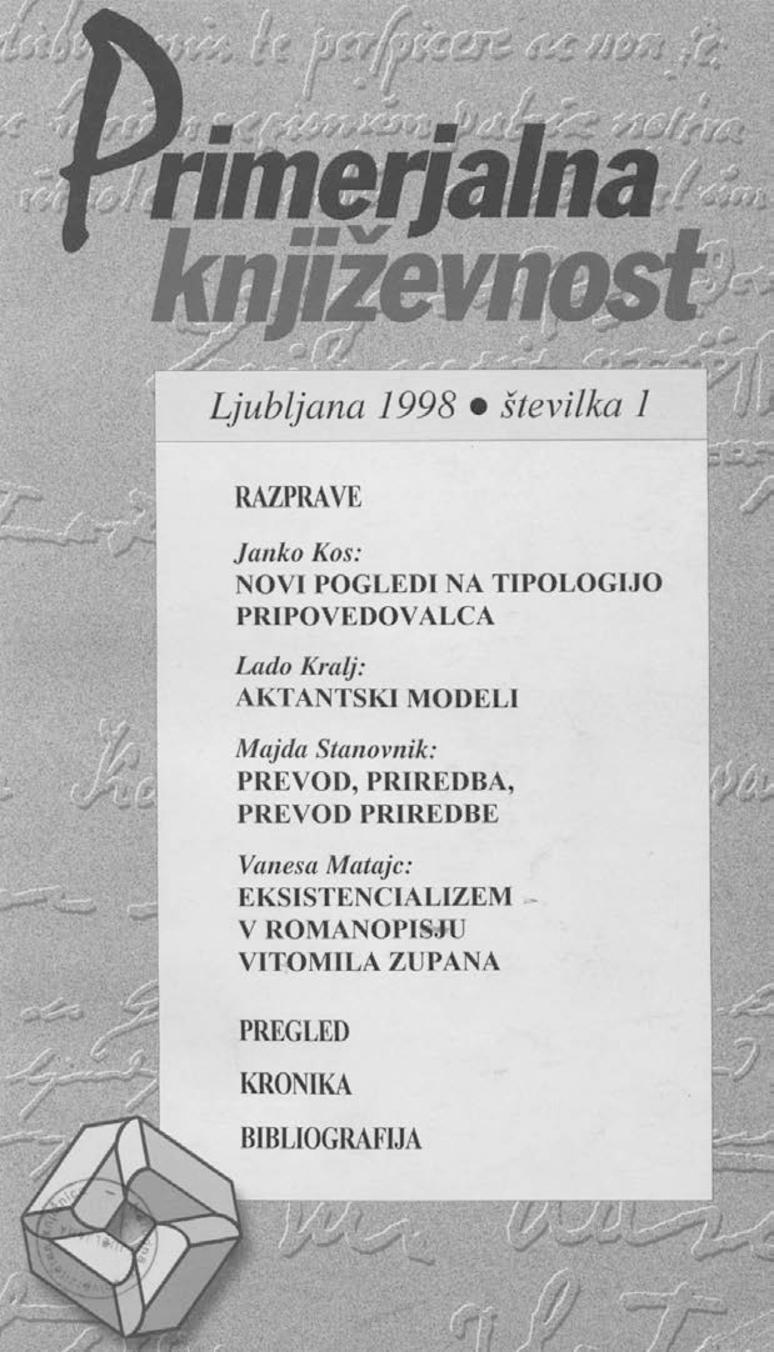Prevod, priredba, prevod priredbe
Ključne besede:
literarna teorija, teorija prevajanja, prevodne zvrsti, izvirnik, priredba, prevod, Shakespeare, William, Lamb, Charles in Mary, prevodi v slovenščinoPovzetek
Prevod in priredba sodita k različnima besedilnima zvrstema, a se pogosto tudi prepletata v deloma prevedenih, deloma prirejenih besedilih, ki so navadno označena kot »svoboden«, »dinamično ekvivalenten«, »funkcionalen«, bralcu prilagojen prevod. Oba spadata med genetsko sekundarna besedila, pogojena s primarnimi, toda po razmerju do izhodiščnega besedila se razlikujeta: prevod je jezikovno v celoti drugačen od izvirnika, ohranja pa njegovo individualno in zvrstno oblikovanost; priredba spreminja izvirnikovo namembnost, pogosto tudi zvrstno pripadnost, vendar se razpoznavno navezuje nanj s parafrazami in citati. – Različna narava prevoda in priredbe se nazorno pokaže ob prevodih izvirnika in priredbe, ki so zavezani vsak svojemu izhodiščnemu besedilu ne glede na to, ali je izvirno ali izvedeno. I. Črnagoj (1953) in I. Majaron (1995) sta npr. Lambovo »pripovedko« po Shakespearovi verzni drami Romeo in Julija prevedla prozno, neoznačenih citatov Shakespearovega besedila nista povzemala po verznem prevodu O. Zupančiča (1940).Literatura
CUDDON, J. A., 1985: A Dictionary of Literary Terms. Revised Edition. Penguin Books. Middlesex.
GLASBA, 1984: Ur. Ksenija Dolinar. Cankarjeva založba. Ljubljana. (Leksikoni Cankarjeve založbe.)
GRAND LAROUSSE ENCYCLOPEDIQUE, 1960. I. Librarie Larousse. Pariz.
GROSMAN, Meta, 1994: »Status književnega prevoda v ciljni kulturi.« – Prevod–posnetek, reprodukcija, interpretacija. Društvo slovenskih književnih prevajalcev. Ljubljana. (18. prevajalski zbornik.)
GROSMAN, Meta, 1997: »Književnost v medkulturnem položaju.« – Razprave II. razreda XVI. Ur. Jože Pogačnik. Slovenska akademija znanosti in umetnosti. Ljubljana. Str. 47–66.
GSPAN, Alfonz, 1956: »Razsvetljenstvo.« – Zgodovina slovenskega slovstva I. Do začetkov romantike. Slovenska matica. Ljubljana.
JAKOBSON, Roman, 1989: »O lingvističnih vidikih prevajanja.« Prevedla Zoja Skušek Močnik. – Lingvistični in drugi spisi. Ljubljana. (Studia humanitatis.)
KIDRIČ, France, 1938: Zgodovina slovenskega slovstva od začetkov do Zoisove smrti. Slovenska matica. Ljubljana.
KMECL, Matjaž, 1995: Mala literarna teorija. Četrta, popravljena in dopolnjena izdaja. Mihelač in Nešović, Založba, d. o. o. Ljubljana.
KOBE, Marjana, 1987: »O priredbah. Priredbe klasičnih del iz svetovne književnosti za mladino v slikanicah za najmlajše.« – Pogledi na mladinsko književnost. Mladinska knjiga. Ljubljana.
KOCIJANČIČ POKORN, Nike, 1997: »Teoretične osnove za kritično vrednotenje prevoda.« – Kriteriji literarnega prevajanja. Prevajanje in terminologija. Društvo slovenskih književnih prevajalcev. Ljubljana. (21. prevajalski zbornik.)
KOVAČIČ, Irena, 1994: »Prevajanje med skoposom in relevantnostjo.« – Prevod–posnetek, reprodukcija, interpretacija. Društvo slovenskih književnih prevajalcev. Ljubljana. (18. prevajalski zbornik.)
KOVAČIČ, Irena, 1996: »Strukturna in pragmatična enakovrednost izvirnega in prevodnega besedila.« – Prevod besedila. Prevajanje romana. Društvo slovenskih književnih prevajalcev. Ljubljana. (20. prevajalski zbornik.)
LAMB, Charles, 1990: »Romeo and Juliet.« – Charles in Mary Lamb, Tales from Shakespeare. Tiger Books International PLC. London.
LAMB, Charles, 1995: »Romeo in Julija.« – Charles in Mary Lamb, Zgodbe po Shakespearu. Prevedel Igor Majaron. Založba Karantanija. Ljubljana.
LAMB, Charles, 1996: »Romeo in Julija.« – Charles in Mary Lamb, Pripovedke iz Shakespeara. Prevedel Ivan Črnagoj. Mladinska knjiga. Ljubljana.
LITERATURA, 1977: Ur. Ksenija Dolinar. Cankarjeva založba. Ljubljana. (Leksikoni Cankarjeve založbe.)
MORAVEC, Dušan, 1978: »Shakespeare pri Slovencih.« – William Shakespeare, Zbrane gledališke igre. I. Ur. Matej Bor. Mladinska knjiga. Ljubljana. Str. 43–139.
OŽBOT, Martina, 1997: »Parametri prevajanja literarnozgodovinskih besedil.« – Kriteriji literarnega prevajanja. Prevajanje in terminologija. Društvo slovenskih književnih prevajalcev. Ljubljana. (21. prevajalski zbornik.)
SHAKESPEARE, William (brez letnice): Romeo and Juliet. – The Complete Works of William Shakespeare. Ur. William George Clark in William Aldis Wright. Groooset & Dunlap Publishers. New York.
SHAKESPEARE, William, 1940: Romeo in Julija. Prevedel Oton Župančič. Slovenska matica. Ljubljana. (Vezana beseda.)
ŠALAMUN BIEDRZYCKA, Katarina, 1990: »(Še enkrat) primerjava med Beaumarchaisovim Figarom in Linhartovim Matičkom.« – Primerjalna književnost, 13, št. 1, str. 15–26. Slovensko društvo za primerjalno književnost. Ljubljana.
TOPORIŠIČ, Jože (ur.), 1993: Slovenska zvrstna besedila. Sour. Velemir Gjurin. Univerza v Ljubljani. Filozofska Fakulteta. Seminar slovenskega jezika, literature in kulture. Ljubljana.
VINAY, J.-P., DARBELNET, J. 1968: Stylistique comparée du français et de l’anglais. Méthode de traduction. Didier. Pariz, Bruselj, Montreal. (Bibliothèque de stylistique compareée.)
WILPERT, Gero, 1969: Sachwörterbuch der Literatur. Kröner Verlag. Stuttgart. (Kröners Taschenbücher, Band 231.)


